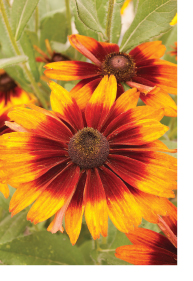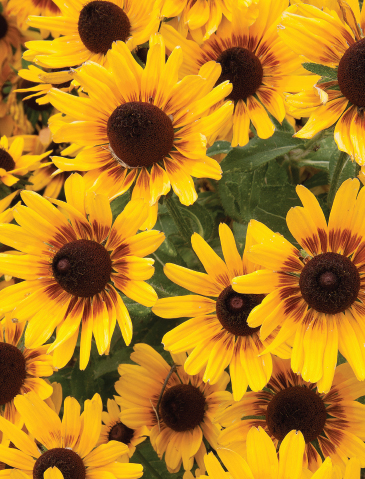The native black-eyed Susan has long been a standard beauty in southern gardens. Whether Rudbeckia hirta that blooms in early summer or the later flowering R. triloba and R. fulgida, these Suzies have been steady performers, dependably bringing cheer with their abundance of bright yellow flowers.
Hybridizers have also noticed the dependability — as well as deer resistance — of black-eyed Susans, and as a result, have been busy developing new, fancier cultivars. And with many of these new introductions, it seems little black-eyed Suzy is growing up — she has discovered lipstick and makeup. Below is a sampling of some of the more colorful variations available to gardeners today. They can be found for sale online, but before e-shopping, check with your local garden centers to see if they have these or similar selections.
 Autumn Colors. Black-eyed Susan’s signature yellow petals are beautifully accented on this selection with streaks of burgundy, bronze and orange. Add to such a merry mix of colors the fact that the blooms can grow almost 7 inches in diameter, and you have quite an attention-getter in the garden!
Autumn Colors. Black-eyed Susan’s signature yellow petals are beautifully accented on this selection with streaks of burgundy, bronze and orange. Add to such a merry mix of colors the fact that the blooms can grow almost 7 inches in diameter, and you have quite an attention-getter in the garden!
Prairie Sun. A green-eyed cutie, it was a 2003 All-America Selection winner, and for good reason — it brims with 5-inch, long-lasting flowers with petals that start golden yellow at the bases and fade to a pretty butter hue on the tips.
Moreno. This short (12 to 18 inches tall) plant goes long on blossom colors. Its petal bases are a rich mahogany-red, but mellow to bronze, then orange, and finally finish in yellow on the tips.
Denver Daisy. Need more flower power? Try a cultivar with blooms as large as 8 inches in diameter! It also flaunts dark brown center cones surrounded by yellow petals dipped in red at their bases.
Green Wizard. Weird — that’s the only way to describe this intriguing cultivar. The large center cones look like black strawberries, and they are ringed by green sepals — no flower petals.
Easily preserved, the blooms make striking, bordering on strange, additions to dried arrangements.
Cherry Brandy. As advertised, this sassy Suzy parades blooms devoid of yellow that, instead, simmer in shades of red — very different! This winner of the Fleuroselect Novelty Award in Europe shows off a bounty of blooms on compact, 2-foot-tall plants.
Prairie Glow. Looking more like fire wheels than flowers, the bicolor blossoms of this beauty have petals that start as orange-red streaks that quickly give way to bright yellow tips.
Cherokee Sunset. Orange, bronze, yellow, reddish-brown — these are the colors of this 2002 All-America Selection winner, which boasts semi-double and double flowers that mimic the hues of, what else? A magnificent sunset.
L.A. Jackson is the former editor of Carolina Gardener Magazine. Want to ask L.A. a question about your garden? Contact him by email at lajackson1@gmail.com.
To Do in the Garden
March
Double your pleasure with summer and fall-blooming perennials by dividing and transplanting such beauties as ajuga, asters, astilbes, daylilies, phlox, oxalis, irises, bleeding hearts, coral bells, helianthus and Shasta daisies.
If perfection is what you seek in hybrid tea roses, start your beauties on a regular fungicide spray schedule as soon as the first leaves appear, to discourage such nastiness as black spot and powdery mildew.
Summer bloomers such as rose of Sharon, vitex, crepe myrtle, pomegranate and butterfly bush that flower on new wood should be pruned at the beginning of this month.
Early this month, the vegetable garden can swing into action with plantings of such cool-tolerant veggies as kale, kohlrabi, lettuce, mustard greens, potatoes, beets, carrots, spinach, radishes, broccoli, cauliflower and Chinese cabbage.
Clean old nests and debris out of bird houses to have them ready for early spring occupation by your feathered friends. Also, give the bird feeder and bath a good cleaning, and refill with fresh food and water.
April
The middle to the end of this month should be prime time to fill the veggie patch with plantings of warm-season edibles such as tomatoes, watermelons, cucumbers, green beans and squash.
Azaleas, camellias, laurels, rhododendrons and wisteria are early spring bloomers that can be pruned after their flowers are spent. It is also a good time to fertilize these ornamentals to prepare them for next year’s flower show.
Any perennials that have a penchant to flop should be staked now before they begin to grow long and lean.
Need a quick-growing, living fence? Now is a good time to plant such annual crawlers and sprawlers as moonvine, morning glory, cypress vine, sweetpotato vine and purple hyacinth bean.
Go easy on using excessive nitrogen on plants such as blackberry, cotoneaster, pear, apple, quince, raspberry and pyracantha, as new growth that develops too quickly will be susceptible to fire blight.
Timely Tip
Whether species or cultivar, annual, biennial or perennial, black-eyed Susans have similarities.
First, they do best if provided with a moderate amount of low-nitrogen fertilizer over the growing season — too much nitrogen encourages excessive foliage production at the expense of flowers.
Second, most Rudbeckias love the sun, but providing a little bit of shade late in the afternoon will prolong the fresh look of their flowers. Also, powdery mildew is a possible problem, so for better air circulation to help minimize this disease, locate the Suzies in an open area and don’t overcrowd the plants.
And finally, watch for slug and snail damage, especially on young plants.







